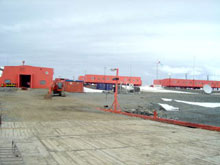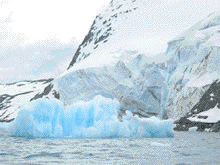
View of Korea's King Sejong Base from the loading dock. Image courtesy of NOAA/Vents, Korea Polar Research Institute (KOPRI)
King George Island, Antarctic
December 5, 2005
William Hanshumaker
Oregon State University
Public Marine Education Specialist
Extension Sea Grant Faculty
Weather: Partly-cloudy with temperatures just below
freezing,
Winds: 15 knots with wind gusts up to 25
The weather determines our daily activities. We need to wait for the wind to subside so that we can take the Zodiac for a close-up view of the nearest glacier. But if it was't for the icy view from the window, I might be sitting in front of my computer back in Oregon.
The housing is well insulated and heated, but the windows have black curtains to shut out some of the twenty hours of daylight. The researchers from our expedition are housed together in one dorm, but we need to dress warmly when moving between the other buildings of the base. The buildings are organized by function. You remove your shoes and put on sandals to avoid tracking in dirt when entering a building. Going for meals, getting Web access or taking a shower requires that you pull your boots off and on many times a day. Each building is constructed a couple of meters off the ground. This permits the snow to blow through, at least until the subfreezing temperatures of the austral autumn.
The wind is a constant force here, but today is an exception to the rule. A steady breeze under 15 knots, occasionally punctuated by only slightly stronger gusts, allowed us to board the Zodiac for a trip to the nearby glacier. We again donned the heavy Mustang suits, and gathered at 3:00 at the quay in front of the base.
A dramatic landscape emerged as the science team approached
the glaciers.
![]() Click
image to view a slide show and image credits.
Click
image to view a slide show and image credits.
From the Korean base, the glaciers appear as a nondescript white line on the horizon. But after just a 15 minute boat ride, details began to appear. Vertical and horizonal cracks became apparent, lending both depth and stature to the ice. Shades of white, broken by darker lines, illustrate the dynamic nature of this ice flow. The closer we drew, the more dramatic this landscape became. Blue ice, almost translucent, is sandwiched between the white layers. This dense blue ice mimics the blue of the sky we observed during our arrival flight.
After a several more minutes of boat travel, the surrounding water began to tell its tale. This section of the bay is called Marian Cove and it extends to some 50 meters in depth. But it isn't possible to determine this depth change merely by the change of the color of the seawater. The melting fresh water from the glacier mixes with the denser salt water, changing its refractive color to a turquoise tint. As we more closely approach the glacier, both the presence of both sediment and fresh water turns the surface into a light shade of azure.
As the dark layers of rock heat up from solar energy, ice melts, and then refreezes, forming dramatic icicles that hang down several meters. The base of the entire glacier is eroded by the action of the waves, creating a uniform overhang about a meter high and a meter deep. Large, vertical cracks in the glacier create blocks of ice, hanging precariously by unseen forces. We were careful not to approach too closely, because of the unpredictable nature of icefall. Though this didn't occur while we were there, small icebergs abound in the cove, indicating the frequency of calving. Some bergs lie low in the water, creating hazardous conditions for moving boats. Many others are sculpted by wind and water into fantastic shapes, each unique to itself.
After a too brief of a period, we needed to return to base. Careful to avoid the floating ice, we sped back in the Zodiac, impressed with the majesty of the dynamics of ice.Sounds of the Southern Ocean will be sending several reports from Dec 3 - 13. Please check back for additional logs from this expedition.
Sign up for the Ocean Explorer E-mail Update List.













